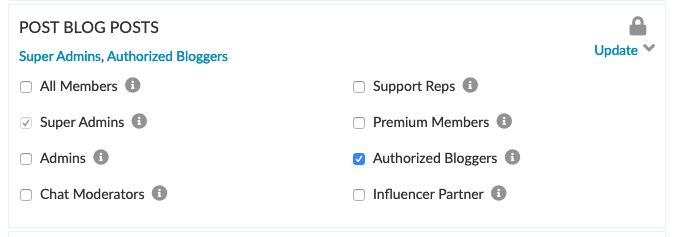Your default permissions reflect the way most Crowdstack owners like to have things work, but you have control if you want things to change things up.
In Crowdstack, you determine the specific actions your members can perform via

Permissions are not assigned per member, but through "roles." A role represents a group of members in your Crowdstack. Thus, you can assign specific permissions to a role and add specific members to each role (who then inherit the role's permissions). You can manage your roles via
Crowdstack has several standard roles, including:
- World: Anyone who visits your Crowdstack, including non members.
- All Members: All registered members.
- Admins: Can perform administrative tasks, excluding those reserved for Super Admins.
- Super Admins: Have controlling authority. Can perform all functions- including managing billing, roles and permissions, premium memberships, and more.
Depending on your plan, you may be able to create your own custom roles.
Implicit Roles
You cannot add members to the World or All Members roles because they are implicit roles that describe a state. In the case of the World role, it refers to any visitor to your Crowdstack - members, non members, guests - anyone who is able to gain access. The All Members role, on the other hand, refers to anyone who is an active member of your Crowdstack. You cannot add members to that role because every member implicitly belongs to that role.
Permissions Are Additive
In the permission model that Crowdstack uses, a member's specific permissions are based on all of the roles that member is associated with. Thus, if Kim is an Admin, she would have all permissions associated with the World, All Members, and Admins roles. If Joe is a regular member, he would have all of the permissions associated with World and All Members.
No Negative Permissions
You cannot remove permissions from an individual member, since permissions are always only applied through roles. Thus, there is no concept of negative permissions.
Owner
Each Crowdstack has only one owner - one person who is listed as the responsible party for the account. The owner always has the Super Admin role. Ownership may be granted to someone else in your Crowdstack, but only to another Super Admin. (You can change ownership via the Super Admin role administration area.)
For more on how to set permissions, see our knowledge base post.